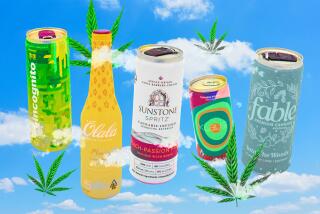American Spud-nik
- Share via
Gray Ottley is an idealist. Had he grown up in the inland empire, surrounded by lemon trees, he undoubtedly would have made lemonade, but then who wouldn’t have?
As it was, the 36-year-old Ottley spent his youth in Idaho looking out at sprawling potato fields and thinking about what you could do with all those Russets besides julienne them and fry them in hot vegetable oil. What he decided to do was turn his life over to vodka.
This wasn’t exactly an original idea. The potato-vodka revolution broke out in spud-rich neighborhoods of Poland and Russia and thereabouts hundreds of years ago and has been going strong ever since. But that doesn’t mean Ottley’s vision made a lot of practical sense.
For one thing, it takes an ungodly amount of Idaho’s finest to make a bottle of vodka, something in the neighborhood of 10 good-sized taters. And that can get expensive. If you use corn, which is what the big boys do, it costs about 60 cents to make the distilled alcohol for a case of vodka. If you use potatoes, it costs at least 10 times more.
Which is why I call Ottley an idealist. Back in the mid-’90s, when he decided to join his father in pursuing this crazy dream, he knew how pricey it was to make vodka from potatoes, but he also knew that most spirit experts consider potato vodka far superior to the other stuff. It’s sweeter and smoother, and when it slides down your throat it doesn’t feel like you’re swallowing a fire poker.
There were other hurdles besides the monetary. If you want to do the right thing and make vodka from potatoes instead of barley or sugar cane, you need a potato alcohol distillery and, frankly, there aren’t a heck of a lot of those around. In fact, when Ottley’s father, Philip, and two partners first went looking in the late ‘80s, there weren’t any potato distilleries in the U.S. at all.
In Rigby, Idaho, however, there was a dilapidated fuel-alcohol plant left over from the Jimmy Carter days, when folks thought potatoes converted into ethanol alcohol might be able to power pickup trucks and such. The potatoes-instead-of-oil thing didn’t work out, and the ethanol plant closed down shortly after Carter moved out of the White House. It had been sitting there for six years, waiting for some crazy entrepreneurs to come along and convert it into a vodka distillery, which is what Philip Ottley did.
At this point, the Distilled Resources Inc., as it was christened, had the raw material, a state-of-the-art production process and some test cases of pretty dang good vodka. Only one key ingredient was missing: consumers.
The Ottleys and their partners had become experts at distilling potato vodka, but they were babes in the woods when it came to selling the stuff. They figured they should concentrate on what they did best, which was making vodka, and let other people figure out how to distribute and sell it. Before long, they had partnered with other quixotic entrepreneurial outfits to offer not only the finest American potato vodka on the market but some of the best vodka, period.
They weren’t so crazy, it turns out. Two Ottley-born vodkas, Blue Ice and Teton Glacier, have been rated by the spirit industry’s Beverage Testing Institute in Chicago as better than just about any vodka you can think of, including the ones you’re probably most familiar with. In late 2003, the institute awarded Teton Glacier 92 points and Blue Ice 93 points, higher than all but a handful of European vodkas.
“We’re demonstrably better than most other ‘luxury’ vodkas,” says John Salisbury, chairman of National Distillers Products Co., which owns the Teton Glacier brand. He chafes at the idea of hipsters strolling into some hot L.A. bar and ordering a so-called premium vodka that costs, say, 30% more than Teton Glacier but tastes inferior. “If we were owned by a wealthy owner or a big corporation, we’d probably be selling a million cases a year,” he says. “As it is, we’re selling at a rate of 10,000 cases a year. But we know we’re one of the great vodkas in the world.”
Jim Myerson, president of 21st Century Spirits, which owns Blue Ice, feels pretty much the same: “It isn’t bragging when I say we’re the best American vodka out there.”
Which leaves the final word to Gray Ottley: “It’s a lesson in life: Even from something as simple as the potato can come great things.”
More to Read
Eat your way across L.A.
Get our weekly Tasting Notes newsletter for reviews, news and more.
You may occasionally receive promotional content from the Los Angeles Times.









